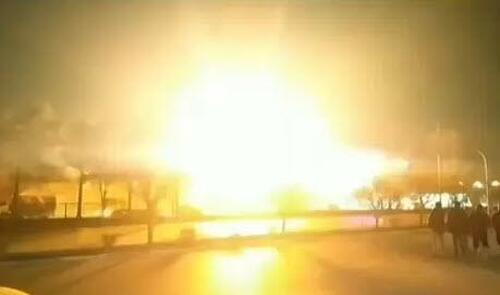Iranian Explosions: Implications And Impact On Oil
Authored by Wouter Schmit Jongbloed via ‘Money: Inside and Out’ blog,
Overnight, the sky over Iran was lit up by at least two explosions targeting military production facilities: one in Isfahan and one in Tabriz. Whether the two explosions are connected remains unclear as the Isfahan target appears to have been an “ammunitions” factory and the explosion in Tabriz occurred at a motor oil factory. Some sources (here) suggest the list of targets hit might be larger and include the Headquarters of the IRGC and some other military targets.
While no party has claimed direct responsibility for the explosions, Senior Ukrainian spokesperson Mykhailo Podolyak tweeted “War logic is inexorable & murderous. It bills the authors & accomplices strictly. Explosive night in Iran – drone & missile production, oil refineries. Did warn you.”
While drones can be launched from any platform without much infrastructure, it is worth noting that the most common Iranian suicide drones have a range of roughly 2500km and the distance between Kherson, Ukraine, and Isfahan, Iran, is approximately 2600km — so barely in tentative range.
The regime in Teheran is, somewhat predictably, down-playing the impact of the explosions, noting of the Isfahan attack that one drone was shot down “and the other two were caught in defense traps and blew up. [The attack] caused only minor damage to the roof of a workshop building. There were no casualties.”
At the start of the Asian open, oil markets might be primed to price higher risks to oil supplies out of concern that: (i) Ukraine war might be spilling over into Middle East, (ii) Iran might seek retaliation in the region, or (iii) general unrest in oil producing countries is bad news for supply.
As Iran seems to be downplaying the attacks and no clear culprit has been identified (despite Ukraine’s early response), any spike in oil prices could be driven initially by algorithmic trades immediately at the open and thus likely to fade as more information becomes available.
To reiterate:
1/ it doesn’t seem oil production facilities were the target;
2/ even past attacks on Saudi oil infrastructure such as by Yemeni militants (with Iranian backing) in 2019 had a limited impact on oil prices beyond the very short term. 3/ Iran is a marginal producer (though admittedly the market is petty tight)
Will Oil Prices Spike as Markets Price Increased Destabilization?
Previous episodes of violence and explosions involving oil producing countries has led markets to price supply concerns. In somewhat comparable situations, such as Yemen’s missile strikes against Saudi Arabia for instance in March 2022, the oil price reaction function seemed driven in large part out of concern for escalation.
In the current circumstances, three risk avenues could drive market concern:
(i) Ukraine War Spill Over to Middle East
As we do not have a clear sense of responsibility for the explosions in Iran, it’s too early to assume Iran is being targeted as a function of the War in Ukraine; other possible agents include domestic groups behind recent protests and, of course, Israel — though the type of relatively unsophisticated and ineffectual strike makes direct Israeli involvement less likely.
Spill-over risks from the war in Ukraine are real, with the risk-vector Iran stepping up its overt support for Russia, adding its military and industrial capabilities (such as they are) to that of Russia in the production of drones and missiles.
Considering Iran is already suspected of providing material aid to Russia and the seeming determination by Teheran to minimize the explosions this morning, the risks of spill-over seem contained.
(ii) Iranian Retaliation in the Region
While the risk of direct involvement by Iran in the War in Ukraine does not present a central case scenario, elevated risks are present for Iran to seek to lash out regionally to emphasize its continued ability to project force (in the face of being hit domestically).
Of concern to markets could be the increased risk of Iranian attempts to sabotage or derail the energy supply to Europe. Considering Saudi Arabia’s non-confrontational attitude toward Russia lately, an Iranian threat in retaliation against the Kingdom is not likely at this time. Energy transits however could be targeted if the regime feels particularly vulnerable due to this morning’s explosions.
(iii) Elevated General Unrest in Oil Producing Countries
Markets generally respond poorly to upheaval in oil producing countries, especially when global demand is expected to respond to China’s reopening post Zero-Covid. These nebulous concerns are often short-lived though and price reactions fade.
Implications: Pushing Iran Further into Russia’s Camp? JCPOA?
The longer term implications of heightened “homeland” insecurity in Iran might well be a drive in Teheran to consolidate its alliances with Russia and China. The more Iran depends on Russia and China, the fewer diplomatic stepping stones are available to the West to present Iran with credible incentives not to develop a nuclear capability.
As US NSC official Admiral Kirby noted in December: “Russia is offering Iran an unprecedented level of military and technical support that is transforming their relationship.” Such support could include expertise in crowed control measures, but might also involve the delivery of fighter planes (Su-35), air-defense capabilities and potentially helicopters.
Russian support for Iran in nuclear matters is likely more fraught, with Moscow remaining wary of providing Iran with obvious pathways to a nuclear break-out moment. Its disastrous invasion of Ukraine could however marginally reshape Russia’s strategic calculus, making an alliance with Iran more palatable.
Last week, the US, UK and EU imposed fresh sanctions on dozens of Iranian officials and are actively considering designating the Islamic Revolutionary Guard Corps a terrorist organization. With relations between the West and Iran at a low point, the future of the JCPOA remains unclear and in “the deep freeze,” with all blocks satisfied that the nuclear status quo is acceptable (for now).
* * *
Tyler Durden
Sun, 01/29/2023 – 17:30
via ZeroHedge News https://ift.tt/M9msGgH Tyler Durden
